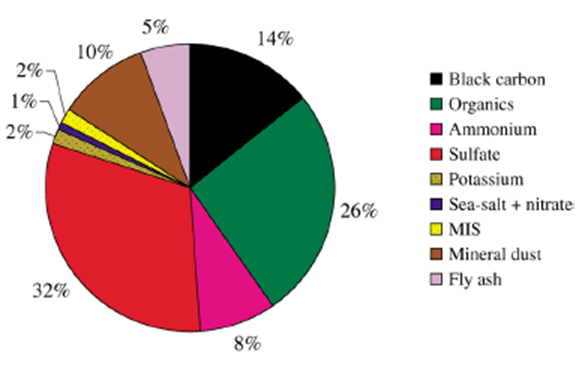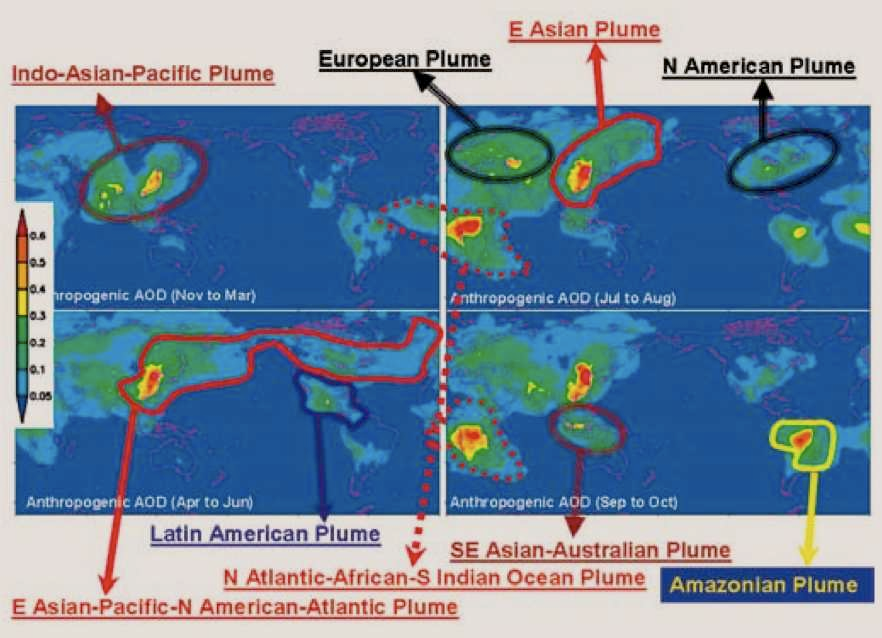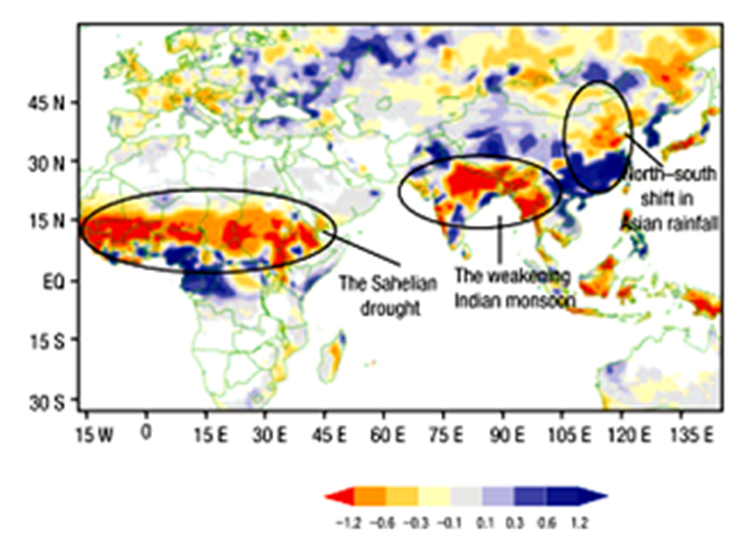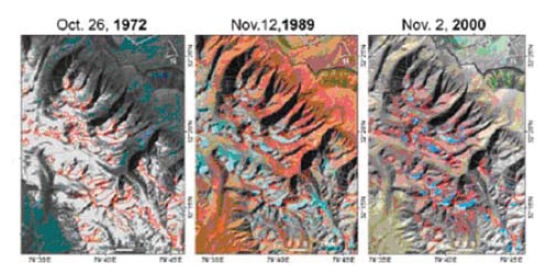Impact Assessment
ABCs have significant negative impacts on regional climate, water resources, public health, glaciers and agriculture production. Two landmark reports have been published by ABC programee on the impact assessment of atmospheric brown clouds.
The first report "The Asian Brown Cloud: Climate and Other Environmental Impacts" was published in 2002 based on Indian Ocean Experiment (INDOEX) study (press release). The report summarized that Asia is a big emitter of ABCs. Direct chemical measurements showed that the anthropogenic aerosols, with a typical composition of 10-15% black carbon (BC), 26% organic (OC), 32% sulfate, 10% mineral dust, 5% fly ash, and smaller fractions of various other chemicals contributes as much as 75% to the observed atmospheric haze over Asian atmosphere.

Figure 1: Fractional contribution of chemical components to the INDOEX aerosol, as measured over the Indian Ocean by aircraft. The total mass concentration is 22 μg/m3. MIS is minor inorganic species. These are free troposphere measurements and do not include boundary layer sea-salt.
Aerosol optical depth (AOD) in visible wavelengths varied from about 0.05 over the Southern Indian Ocean (typically unpolluted air) to between 0.4 and 0.7 over the Arabian Sea and the Bay of Bengal. The climatic impacts of the aerosol haze causes a reduction in spatial and temporal mean solar energy at the earth surface with significant heating of the atmosphere. Aerosol induced haze changes the climate system which significantly impacts hydrological cycle, ecosystems, and agriculture production in Asian region where a large of population of the world live.
The second landmark report on impacts assessment of ABCs "Atmospheric Brown Clouds: Regional Assessment Report with Focus on Asia" was published in 2008 (press release), corrective statement. This was a compressive report which revealed that the ABC is a global phenomenon, spread heterogeneously over several parts of the world. This report, using the satellite and regional assimilation models, first time presented chemical composition of the aerosols in ABCs and how their chemistry contributed to the AOD.
Based on AOD values (>0.3) and percentage of absorbing aerosols (>10%), five ABC regional hotspots were identified, namely, Indo-Gangetic Plain in South Asia, East Asia, Indonesian region, Southern and Central Africa, and the Amazon basin. The impacts of ABCs, such as, atmospheric-hearing and surface-dimming, are mainly confined to the regions of high ABCs emissions in Asia (for example, China and India). The annual mean solar heating of the troposphere over China and India was increased by about 15 per cent.

Figure 2: The integrated satellite data shows anthropogenic aerosol optical depth (AOD) in the period 2001-2003 for four
seasons. AOD is an index for the fraction of sunlight intercepted by particles and total aerosol concentration in the
vertical column. The ABCs over South Asia peaked during the months of November-March. For July-August ABCs
and dust reached peak values over Africa and Middle East. During the boreal spring, the ABCs and dust extended
from East Asia across the North Pacific and further into Atlantic. The Amazonian Plume peaked during September to October.
The rainfall or precipitation trend observed from 1950 to 2002 show that the monsoon over Indian subcontinent, including Southeast Asia, is weakening which imply a decrease in monsoon precipitation over India and Southeast Asia by about 5 - 7 per cent; a north-south shift in rainfall patterns in China i.e. northern China receive less rainfall than that of Southern China; and increasing drought-prone conditions in Sahelian region of the Africa.

Figure 3: Observed trends in summer rainfall: 1950 - 2002
The retreat of the Hindu Kush-Karakoram- Himalayan (HKH) and the Tibetan glaciers is one of the major environmental problems facing the Asian region. These glaciers form the largest bodies of ice and snow, after Greenland and the Antarctic ice sheets. The Himalayan glacial snowfields, which spread in Pakistan, India, Nepal, Bhutan and China, are storage of freshwater with a range of flora and fauna. The HKH and the Tibetan glaciers feed most of major perennial river systems, including the Indus, Ganges, Brahmaputra, Mekong and Yangtze and sustain the livelihood of over a billion Asians. Due to deposition of ABCs, which change ice-albedo and accumulated effects of greenhouse warming, the glaciers and glacial lakes in the HKH system and Tibet are retreating at alarming rates. The HKH glaciers are retreating by 10-60 meter per year. As glaciers retreat, glacier lakes grow and lead to a catastrophic glacier lake outburst floods. Many of the major glaciers in India are also retreating at rates ranging from 10-25 m per year.

Figure 4: Change in the snow and glacier cover in the Western Himalayan region as shown in Landsat multispectral scanner (1972), thematic mapper (1989), and Enhanced Thematic Mapper Plus (2000).
Exposure to ABCs can have an adverse effect on human health. The presence of particulate matter (PM) in ABCs increases the threat posed to human health. Both short-term and long-term exposures of ABC pollutants may result in serious diseases including Asthma, Chronic Obstructive Pulmonary Disease (COPD), Acute Respiratory Distress Syndrome (ARDS), Bronchitis, Pulmonary inflammation, Cancer, and Reproductive and development alterations. ABC pollutants exposures are likely causing about 400,000 to 500,000 deaths in a year in India and China. An estimate of the health costs from ABCs related diseases in China and India could be about 3.6 and 2.2 per cent of the GDP, respectively.
ABCs can have significant impacts on agricultural production. ABC-induced factors including reduction in solar radiation, settling of ABCs on plants, acidification of water and soil, reduction of photosynthesis capacity, and change in hydrological cycle interfere the agricultural production. On an average annual growth in agriculture production is decreased from 3.5 to 1.3 percent in Asia during last five decades.
ABC Programme has established a group of scientists to revise the impact assessment of ABCs on region climate, agriculture production, hydrological cycle, ecosystems, melting of glaciers, human health. This will be published as a 3rd ABC Impact Assessment Report. For that, data analysis and modeling centers have been established at The
Seoul National University (SNU) and
The University of Tokyo (UT).
At present, Modeling and Analysis Team is using 12 models (5 global, 5 regional, 2 radiative transfer) for ABC impact assessments. These models are listed below:
|
Global Models (5) |
|
SPRINTARS |
T. Nakajima and
D. Goto, University of Tokyo and National Institute for Environmental Studies, Japan |
|
GEOS-Chem |
R. J. Park, Seoul National University, Korea |
|
BCC_AGCM2.0.1 |
H. Zhang and
Z. Wang, National Climate Center of China Meteorological Administration, China |
|
EMAC |
M. G. Lawrence, Institute for Advanced Sustainability Studies, German |
|
MATCH |
M. G. Lawrence, Institute for Advanced Sustainability Studies, German |
|
Regional models (5) |
|
CMAQ |
C. H. Song, Gwangju Institute of Science and Technology, Korea |
|
STEM |
G. R. Carmichael, Iowa University, US |
|
WRF-Chem |
S. C. Yoon, Seoul National University, Korea |
|
EMTACS |
M. Kajino, Meteorological Research Institute, Japan |
|
CMAQ |
F. Meng, Chinese Research Academy of Environmental Sciences, China |
Radiative transfer model (2) |
|
MACR |
C. E. Chung, Gwangju Institute of Science and Technology, Korea |
|
FGOALS2_s |
J. Li and
Q. Bao, Institute of Atmospheric Physics, Chinese Academy of Sciences, China |
This data and modeling analysis exercise is named as Intensive Data Analysis (IDA) project.
ABC Reports:
The Asian Brown Cloud: Climate and Other Environmental Impacts, 2002, UNEP
Atmospheric Brown Clouds: Regional Assessment Report with Focus on Asia, 2008, UNEP (Summary),
Atmospheric Brown Clouds: Regional Assessment Report with Focus on Asia, 2008, UNEP (Full Report), corrective statement
